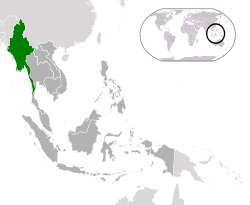Written by: IPCS
By Panchali Saikia
The Rohingya refugee crisis is not a new phenomenon, and it has now grabbed the attention of the international media for all the wrong reasons. The Rohingyas, in large numbers, are now trying to escape to Malaysia via the sea route through Thailand, but are being denied entry by Thai authorities and forcibly pushed back. Earlier this year around 91 persons believed to be Rohingyas were rescued near Andaman Island by the Indian Navy and around 129 by the Indonesian Navy in Aceh. The Rohingyas have been sheltered by Bangladesh for nearly three decades. What is the reason for their escape to Malaysia? Why is Thailand forcibly pushing them back to sea? Thailand has provided shelter to hundreds and thousands of other displaced people from Myanmar, why is then expelling the Rohingyas?
Why Are The Rohingyas Escaping To Malaysia?

Burma
Rohingyas fled repression in Myanmar and lived in exile, mainly in Bangladesh. Since Myanmar’s independence in 1948, its successive governments have attempted every possible way to push them out. The Emergency Immigration Act of 1978 and later the ethnic cleansing campaign known as Naga Min, or Dragon King, prosecuted illegal entrants, primarily in Rakhine state. This drove out nearly 200,000 Rohingyas from Myanmar.
However, after providing shelter to the Rohingyas for nearly three decades, Bangladesh is now concerned about the annual increase in their numbers. Apart from being an economic burden, the Rohingyas’ involvement in insurgent activities along the Myanmar-Bangladesh border is feared by the government. Hence to reduce the influx, the government has declared that it will no more consider any asylum seeker as refugee. Also, it has now denied permits for aid agencies to assist unregistered refugees. Anti-Rohingya communities in Bangladesh have also pressurized the government to repatriate the Rohingyas. Due to the denial of protection, assistance, and fear of repatriation, the Rohingyas are now escaping to Malaysia through the sea route. Malaysia is seen as the best destination because of the religion factor. Also, the Malaysian government’s permit to access the UN Refugee Agency (UNHCR) has attracted asylum seekers.
Rohingyas: A Threat To And Burden For Thailand
This trend has become a major concern for Thailand, as most of these migrants/refugees escaping are landing in Thailand. It is not for the first time that Thailand has pushed them back. In 2008 and 2009, the Thai authorities were condemned by the international community for pushing the Rohingyas into international waters without any assistance or protection.
The Thai authorities are apprehensive of the influx and suspect that the Rohingyas are assisting the Muslim-led insurgency in southern Thailand, which has intensified in recent times. Furthermore, nearly 1 million other migrants from Bangladesh and Myanmar are estimated to already be in Thailand. The exceeding numbers of illegal migrants will add to the economic burden and pose a threat to Thai national security. Unlike the other migrants in Thailand who play a major role contributing to the Thai economy (http://bit.ly/vl6ylg), the Rohingyas are only a liability and burden; they cannot get a work permit in Thailand as this requires a nationality verification certificate which the Rohingyas do not have.
Myanmar’s Denial Of Citizenship To Rohingyas
The primary problem and responsibility should lie with Myanmar. Rohingyas are primarily a Muslim ethnic group from the northern part of Arakan province (Rakhine State) of Myanmar. The term ‘Rohingya’ is derived from the Chittagonian dialect (Bengali language), in which the Rakhaine or Arakanese people are called ‘Rohangya’. In this context Myanmar should consider them a national ethnic group. But, they are denied citizenship and not recognized among the 135 national ethnic groups under the 1982 Citizenship Law, leaving them stateless and as illegal immigrants in their own country. Even under the Constitution of the Republic of the Union of Myanmar which was passed in 2008 it is stated that ‘Citizenship, naturalization and revocation of citizenship shall be as prescribed by law’. Their condition has not improved even today; approximately 800,000 Rohingyas living in Northern Arakan state and Rangon are effectively stateless and are subjected to discrimination and exploitation.
Most of the countries are hesitant to host the Rohingyas because they are denied citizenship in Myanmar and because of this, reaching an understanding with the Myanmar government on their resettlement or repatriation is difficult. For instance, earlier in December 2011 an agreement was reached at a meeting between President Thein Sein and Bangladeshi Prime Minister Sheikh Hasina to repatriate Myanmarese refugees. But the Myanmarese government made it clear that only those refugees who met the key criteria under Myanmar citizenship law would be taken back, leaving the Rohingyas out in the cold.
Thailand has earlier attempted to repatriate refugees to Myanmar (http://bit.ly/s0OVak) but mostly only the Karen and Karenni ethnic groups. The increasing number of Rohingyas will be a serious issue, first, owing to the difficulties in cooperating with Myanmarese government, and second, because of identification. In Thailand’s nine refugee shelters, most of the refugees belong to the Karen and Karenni ethnic groups of Myanmar and only 10-12 per cent is Muslim. As the Rohingyas are not able to register themselves in Thailand, there are no official records on their numbers, because of which resettlement or repatriation becomes impossible.
The plight of the Rohingyas and the growing concern over their influx is not only confined to Myanmar, Bangladesh and Thailand. Other regional powers like India, Indonesia and Malaysia must also engage themselves considering its security implications. The forcible push-backs are a major threat to the maritime as well as border security of these countries. Left with no other option, the Rohingyas are vulnerable to being recruited by sea pirates and involved in arms and drug smuggling.
Panchali Saikia
Research Officer, IPCS
email: panchali@ipcs.org
December 31, 2011
Source: IPCS













